Steamed Perilla leaves or Kkaennip Jjim is a wonderful summertime Korean side dish. Quickly steamed to make the leaves tender while the light seasoning allows you to fully enjoy the fantastic flavor of the aromatic Perilla leaves. Ready in less than 10 minutes! GF
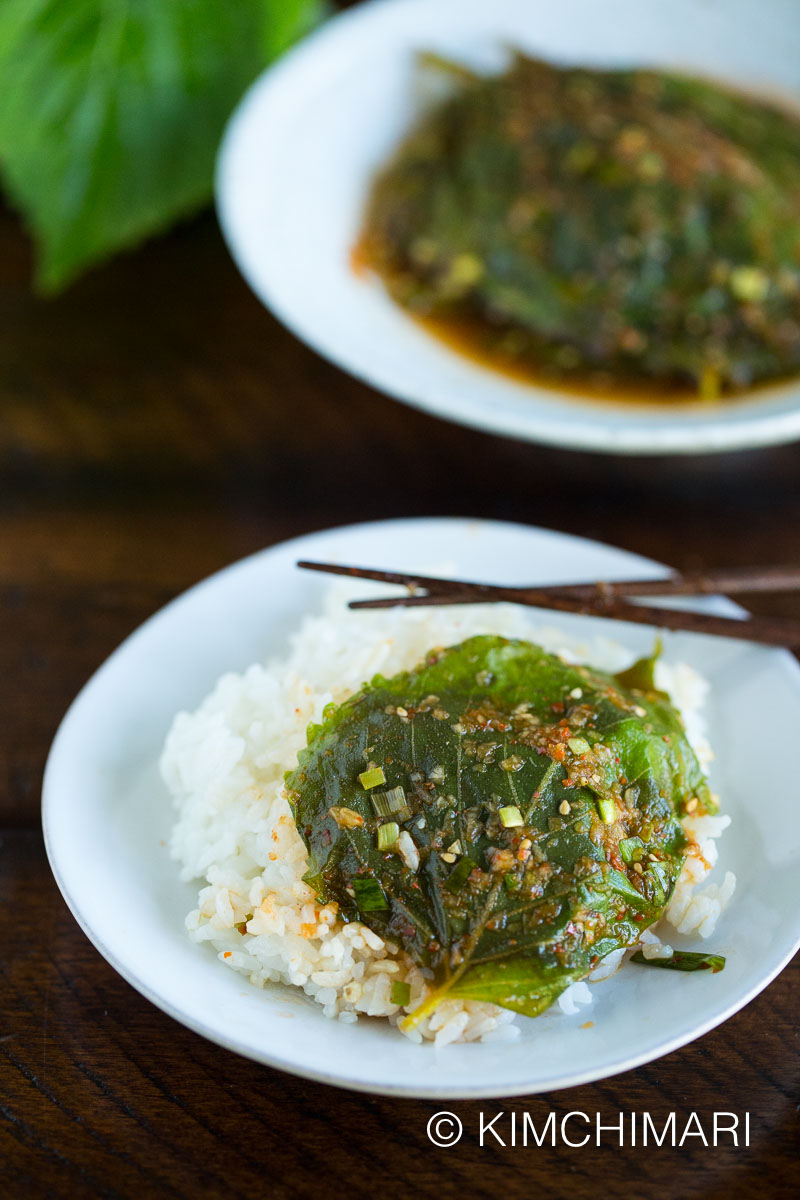
Steamed Perilla leaves (깻잎찜 Kkaennip Jjim) was something I knew I would be making this summer because I planted a little too much Perilla this spring. 😝😝I wasn’t planning on planting so much but…you see…..
It’s all because some creature(s) kept digging up my perilla seeds before they had a chance to sprout!!! Are they birds? Squirrels? I don’t know..
Anyway, after my 3rd try of planting perilla seeds and finding them all disturbed and gone again couple days later, I was so frustrated and angry that I poured a whole bunch of seeds into the ground (the 4th time) instead of planting just a few. Well, this way some should still survive!!! RIGHT?? HAHAHA.. Well, murphy’s law…for some reason, this time, the seeds were not dug up and so not just some sprouted but every seed survived and I ended up with a Perilla forest..😜
I could have thinned it out but shhh…. don’t tell anyone…I am kind of a hoarder when it comes to plants. 😝😜I just cannot remove them once they have taken root nor can I prune trees properly…It just pains me 😰 to pull plants or cut back trees. So, I made Kkaennip Namul twice already, made Perilla Pickles and now I am finally going to steam them!!
What are Perilla Leaves?
It is the leaf of the Perilla plant – Perilla frutescens which is called Deulkkae 들깨 in Korean. Perilla leaves then are called Kkaennip 깻잎. These grow in East Asian countries including India and China. But interestingly, only Koreans eat this plant! Because it is of the mint family, the flavor is slightly minty – somewhat similar to basil or fennel.
Not to be confused with Shiso (Perilla frustescens var. crispa) which is used in Japanese cuisine. Shiso and Korean Perilla are NOT the same. They both belong to the same species but is of a different variety. Shape wise – shiso leaf is smaller and has a more pronounced jagged edge. Flavor wise – shiso tastes mintier and also has an added anise and cinnamon flavor which is a bit too strong for me most of the time.
From the seeds of perilla (ddeulkkae 들깨), Koreans produce perilla oil Deulkkae Gireum 들기름 (not to be confused with sesame oil). BTW, this is what’s used in this recipe.
How to grow Perilla
Perilla is quite easy to grow (unless some creature eats them 🙄) and is even considered a weed in the US, going by the name beefsteak plant, Chinese basil, wild basil, etc. They reseed easily and so it will come back year after year. You can grow them in pots or on the ground. Sowing directly into the soil in spring works best. It does best at constant moisture so water them regularly.
At the end of summer, they will start to flower and then seeds will develop inside. You can collect them, make Deulkkae Garu 들깨가루 (perilla seed powder) or just add the seeds to soups and stews like in my Gamjatang and then replant them again next year.
Eating Perilla Leaves and Meat (Korean BBQ) together is good for you!
People mostly eat perilla leaves and grilled meat in lettuce wraps more for flavor but did you know that this yummy leaf can help to work against the high cholesterol effects of eating meat? There’s even a research study that shows how perilla oil can help to improve Non-alcoholic Fatter Liver Disease (Paper).
And Korean herbal doctors have been saying for years that this leaf is the perfect food pair to beef. Because it is high in vitamin A & C (which beef does not have). Kkaennip also has more iron than spinach. Eating 30g of perilla will meet your daily iron requirement. So eat your Perilla today!!
Cooking
I have 10 ways to eat Perilla leaves post that I wrote some time ago. Check it out for other ideas on how to enjoy this beautiful herb
Storage
Perilla dries or wilts easily so keep them wrapped in a paper towel inside a plastic bag or wrap. Or what I do is, if the leaves are fresh, I just keep them in a plastic container with the top off and cover the top with a wet paper towel and periodically I re-wet the paper towel. This will keep them fresh longer.
Reviving wilted leaves – I do this for kkaennip, lettuce or any leafy green vegetable. If they look dried up or wilted, you can cut the stems off and then soak them in cold water. Leave it for 10-20 minutes and they will come back to life. Then drain them, completely dry each leaf with a paper cloth and then use my storage method to store them.
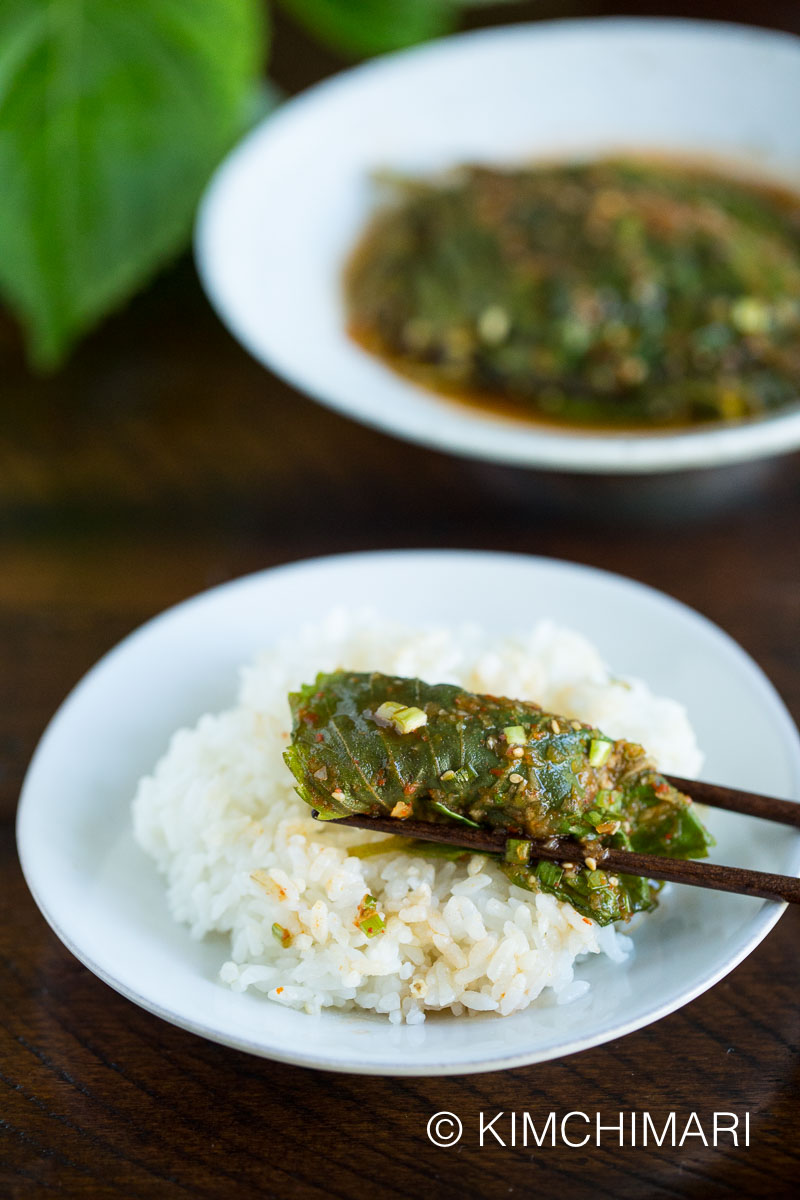
Chef’s Tips for perfect Steamed Perilla Leaves
- Don’t overcook, the color of the leaves should still be quite green and not brown.
- Be sure to alternate the direction of the layers so the overall stack comes up even in the end – this way you make sure the sauce gets evenly absorbed into the leaves. Also, use a wide and shallow pot vs small and tall since the lower the stack is, it is going to have better sauce coverage.
- Try using a shitake kelp broth instead of water, it adds a great umami flavor.
- Apple Lemon Soy Sauce is my homemade seasoned soy sauce (맛간장) that is diluted with sake and sugar then infused with apples and lemon. It really is hard to describe how yummy this is but if you don’t have time to make it, I do have another recipe (below) that is made without it.
- Refrigerate leftover kkaennip jjim. It should last a good week or more.
- How to serve – serve it warm or at room temperature, as a side dish to any meal but especially with grilled meats or pork belly.
Step-by-Step Directions
- Wash and drain perilla leaves. Layer them so they will dry up.
Perilla leaves draining - Finely chop onion (use an electric chopper or blender for quicker prep).
- Chop green onions.
- Make seasoning sauce by adding and mixing the following in a bowl:
- Apple Lemon Soy Sauce (see notes for substitution if you don’t want to make it – although I really recommend you do 😉)
- finely chopped onions
- chopped green onions
- water
- anchovy sauce (myeolchi aekjeot 멸치액젓)
- soup soy sauce (guk ganjang 국간장)
- cooking sake (rice wine or mirin)
- red chili powder (gochukaru 고추가루)
- perilla oil (deul gireum 들기름)
- sesame seeds (kkae 깨)
- maesil syrup (substitute 1/3 tsp sugar 매실청)
-
Seasoning sauce for Perilla
- Then to 4, add chopped onions and green onions.
Chopped onions into sauce - In a wide saucepan (at least 8″),
- spoon 1-2 spoonfuls (small spoon) of the sauce from 5 on the bottom of the pot.
- Then take 3 leaves and stack them in the pan. Pour 1-2 spoonfuls of the sauce on top of the Perilla leaf.
- Take another stack of 3 perilla leaves and add to the pan but turn it 180 degrees so you alternate the direction of the leaves.
- Repeat until done.
How to stack perilla leaves for steaming
- If making more than 40 or so leaves, make 2 stacks inside the saucepan (see video and image #4 above) so the overall height of the resulting stack is lower and more sauce gets onto the leaves during cooking.
- Cover the pot and cook (steam) the leaves on medium heat for only about 2 minutes or 2 1/2 minutes. Because there’s so little liquid, it should start bubbling right away because there’s so little liquid (even though it’s on medium only). If your stack is high, you will also want to turn it over after 1 minute or so until all leaves look wilted. Since we eat Perilla leaves raw, we don’t need to really cook a lot. We just want to cook the rawness out of it. The color of the leaves should still stay pretty green when finished.
- Serve warm or at room temperature or even cold as side dish (banchan) with rice and other dishes. Or goes wonderfully well with Kalguksu or other warm noodles.
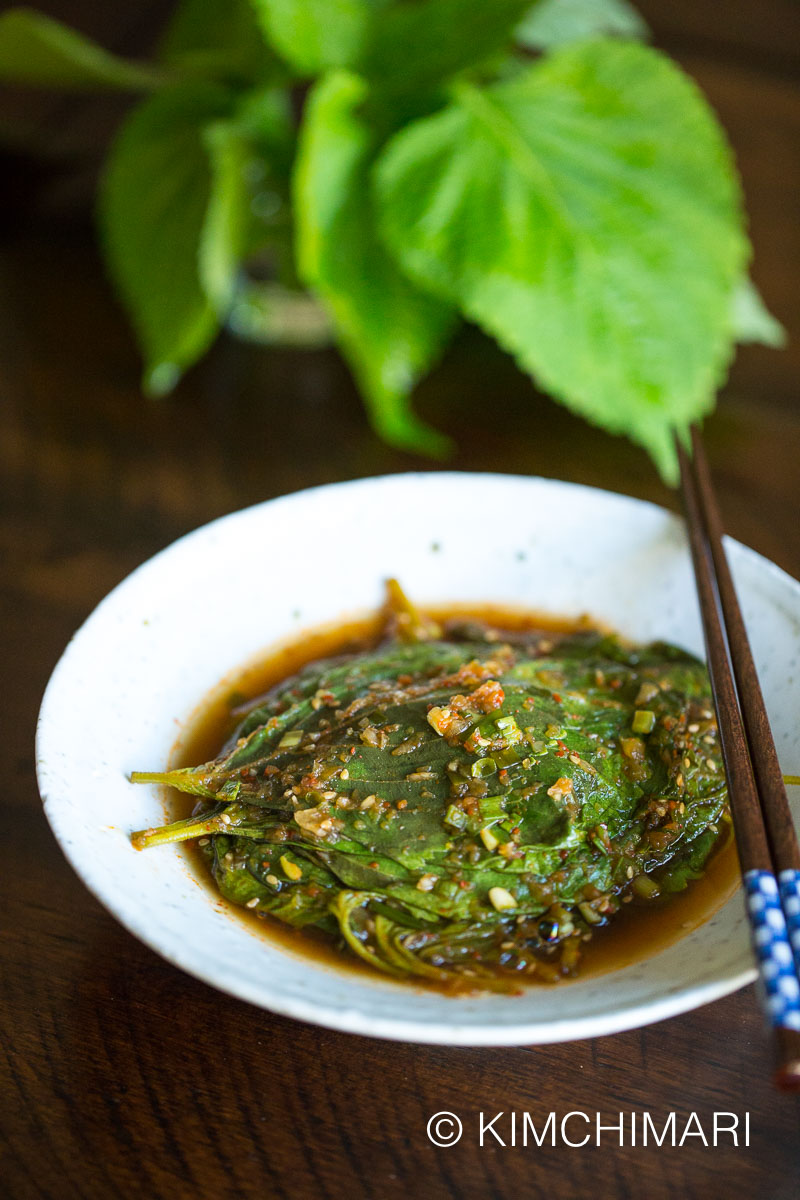
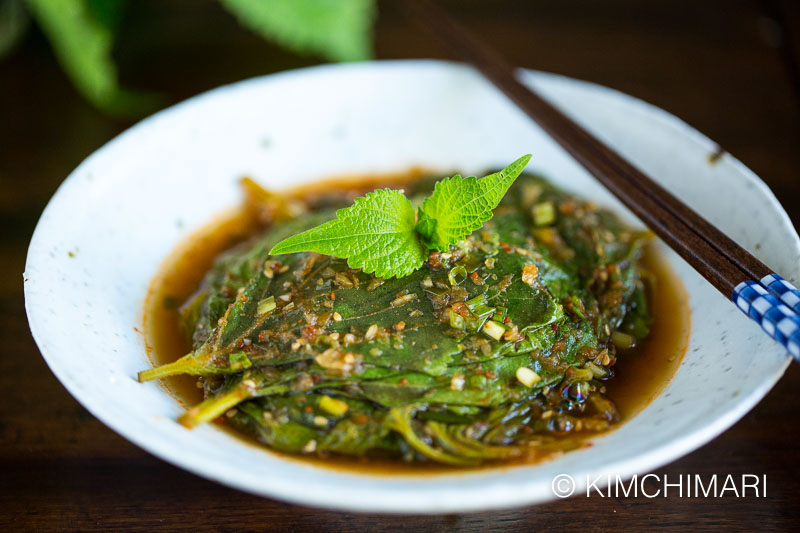
And there you go! Enjoy!!
If you have tried this or any other recipe on my blog then please rate the recipe (☆☆☆☆☆ at the top right of the recipe card) and leave me a comment to let me know how you like it! Every 5 star helps me a lot and I also love hearing from you! 😍
You can also FOLLOW ME on FACEBOOK, PINTEREST and INSTAGRAM or join my FACEBOOK GROUP to ask and share everything about Korean food with others just like you!
Recipe Credit – thank you to my sister #3 for this recipe! She said she loved the one served at a Korean Kalguksu restaurant (Sohojeong 소호정) so much she made a recipe of it! I tried it and I liked it much better than the more common style where the sauce is stronger flavored.
Steamed Perilla Leaves (Kkaennip Jjim)
Ingredients
- 80 pieces perilla leaves
Sauce recipe with Apple Lemon Soy Sauce
- 2 Tbsp Apple Lemon Soy Sauce
- 3/4 cup water
- 4 tsp anchovy sauce (myeolchi aekjeot) (substitute fish sauce)
- 3 Tbsp cooking sake (rice wine)
- 1/2 cup green onions (chopped)
- 1/2 cup onion (finely chopped, blender works well)
- 1 Tbsp red chili powder (Gochukaru)
- 1 Tbsp perilla oil
- 2 tsp sesame seeds
Sauce recipe without Apple Lemon Soy Sauce
- 5 tsp anchovy sauce (myeolchi aekjeot) (fish sauce)
- 1/4 tsp Korean soup soy sauce (guk ganjang)
- 3/4 cup water
- 3 Tbsp cooking sake (rice wine or mirin)
- 1 Tbsp red chili powder
- 1 Tbsp perilla oil
- 2 tsp sesame seeds
- 1/2 cup onion (finely chopped, blender works well)
- 1/2 cup green onion (chopped)
- 1/2 tsp maesil (green plum) syrup (substitute 1/3 tsp sugar)
Instructions
- Wash and drain perilla leaves. Layer them so they will dry easily.
- Finely chop onion by hand or use an electric chopper or blender to do it.
- Chop green onions.
Make seasoning sauce by adding and mixing all sauce ingredients in a bowl:
- Apple Lemon Soy Sauce (see different recipe version if you don't want to make it - although I really recommend you do 😉)
- water, fish sauce, soup soy sauce, cooking sake, red chili powder, perilla oil, sesame seeds, maesil syrup (or sugar), chopped onions and green onions
- In a wide saucepan (at least 8"), spoon 1-2 spoonfuls (small spoon) of the sauce on the bottom of the pan. Then take 3 leaves and stack them in the pan. Pour 1-2 spoonfuls of the sauce on top of the Perilla leaf. Take another stack of 3 perilla leaves and add to the pan but turn it 180 degrees so you alternate the direction of the leaves. Repeat.
- Also, make 2 stacks inside the saucepan (see videso the overall height of the resulting stack is lower and more sauce gets onto the leaves during cooking.
- Cover the pot and cook (steathe leaves on medium heat for only about 2 minutes or 2 1/2 minutes. Because there's so little liquid, it should start bubbling right away. If your stack is high, you will also want to turn it over after 1 minute or so. Since we eat Perilla leaves raw, we don't need to really cook it. We just want to cook the raw taste out of it. The color of the leaves should still stay pretty green when finished.
- Serve it warm or at room temperature or even cold as side dish (banchawith rice and other dishes.
Equipment
- 4 qt saucepan
- bowl
- colander
Tips & Notes:
- substitute 1/3 tsp sugar for 1/2 tsp maesil (green plum syrup).
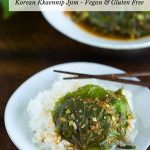
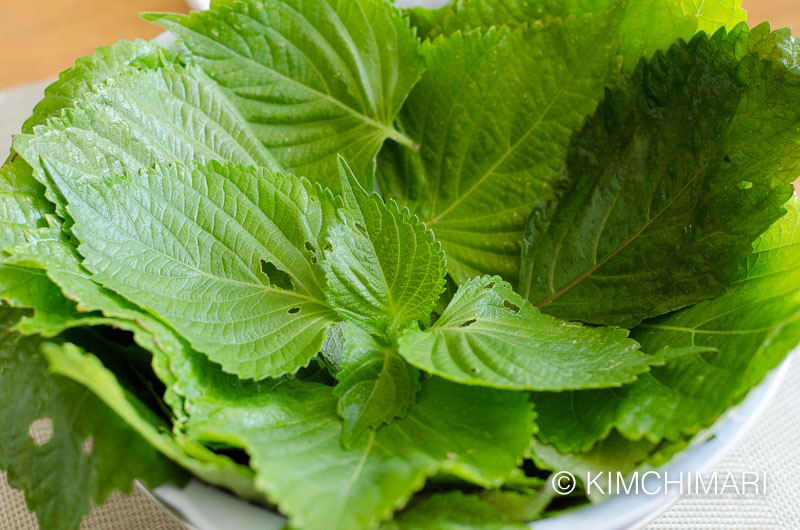



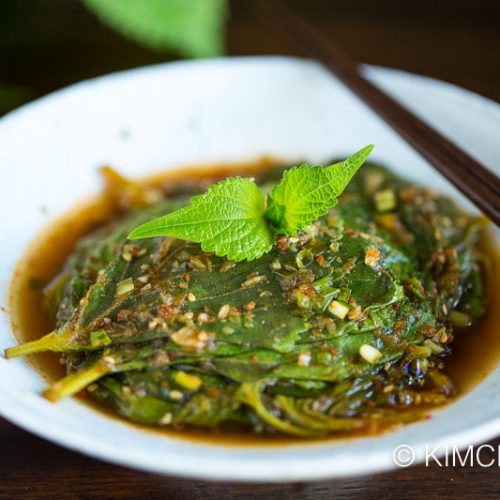
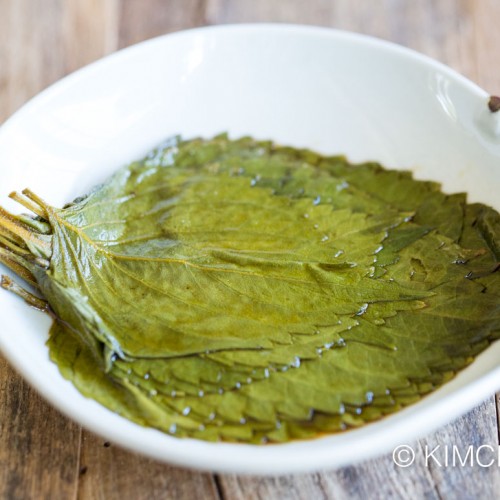
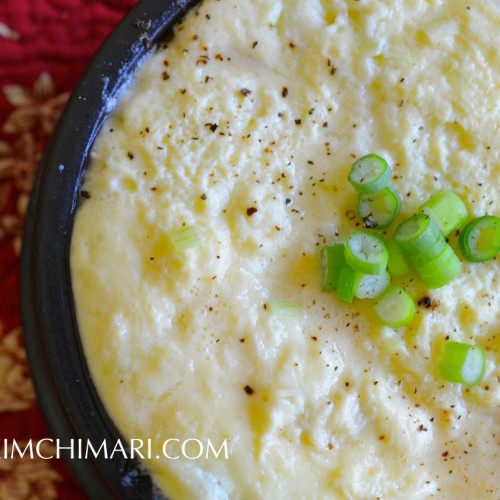
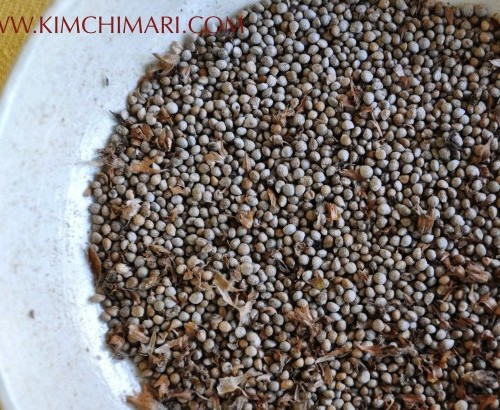
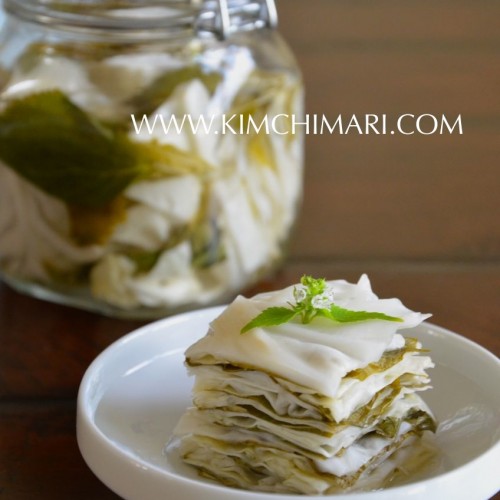
















The English name is beefsteak plant.
Yes, that’s right! Thank you for the reminder.
I thank you for your time and energy sharing all these wonderful recipes/stories. They had perilla leaves at the farmers market last spring. I knew you could use them to wrap things but nothing else. I am so excited to find your site and can not wait to try some recipes! Spring feels a long way off right now especially since we are in the middle of a snowstorm. Blessings and be well
Oh thank you!! Yes, Spring seems a long way off but I’m sure it will be here very soon. And so happy that you like the recipe. I also have a pickle that you make with perilla leaves. HOpe you try that one too! Blessings to you!~
So glad I found this recipe. Finally found perilla leaves again. I had been making them incorrectly. This recipe tastes perfect.
I’m not seeing an amount listed for the onions & green onions?
OMG!! I don’t know what happened! I just corrected it. THANK YOU SO MUCH for letting me know. Enjoy!!
Hi JinJoo, what setting should I use on the stovetop? Sorry for such a basic question but I’m not a good cook (yet?). You wrote that it should start bubbling right away, so does that mean it should be on high? And to turn the stove on after the piles of leaves are stacked up?
No worries – that’s what I’m here for! I did say cook on medium heat (I just changed that into bold so it’s more visible). It starts bubbling right away because there’s so little liquid. And yes, you stack all the leaves and the sauce in the pot BEFORE you turn the stove on. COVER and turn on the heat. Check about 1 min in to see it bubbling and then to turn the leaves over if you think it’s too high. Cover again and cook for another min or so. Good luck. Cheers!